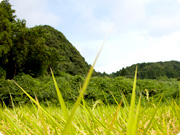The United Nations Decade on Biodiversity
What is the United Nations Decade on Biodiversity

 The United Nations General Assembly at its 65th session (December 20, 2010) declared the period 2011-2020 to be “the United Nations Decade on Biodiversity” (Resolution 65/161). “The Decade of Biodiversity” was proposed by the Government of Japan during “the tenth meeting of the Conference of the Parties (COP10), Convention on Biological Diversity, held in Nagoya, in October 2010. On the last day of the meeting, it was decided to recommend the United Nations General Assembly to adopt the “Decade of Biodiversity.”
The United Nations General Assembly at its 65th session (December 20, 2010) declared the period 2011-2020 to be “the United Nations Decade on Biodiversity” (Resolution 65/161). “The Decade of Biodiversity” was proposed by the Government of Japan during “the tenth meeting of the Conference of the Parties (COP10), Convention on Biological Diversity, held in Nagoya, in October 2010. On the last day of the meeting, it was decided to recommend the United Nations General Assembly to adopt the “Decade of Biodiversity.”
The United Nations Decade on Biodiversity will serve to support and promote implementation of the objectives of the Strategic Plan for Biodiversity for the period 2011-2020. In order to achieve the objectives, it is necessary for United Nation’s organizations, governments, and international society to collaborate each other with the support of Office of Convention on Biological Diversity.
The proposal made by the Government of Japan at COP10 was originally promoted by Japan Civil Network for Convention on Biological Diversity (CBD Civil Net) and Japan Committee for International Union for Conservation of Nature (IUCN). “NGO Initiative for the United Nations Decade on Biodiversity” has been also proposed to support “the United Nations Decade on Biodiversity.”
The fruits of COP10


 The tenth meeting of the Conference of the Parties (COP10) to the Convention on Biological Diversity (CBD) was held in Nagoya, Aichi Prefecture, from October 18 to 29. The meeting drew the participation of more than 13,000 people from the Parties to the Convention from among the 179 countries involved, relevant international organizations, non-governmental organizations (NGOs), and other institutions. As the host country, Japan has been preparing for this meeting together with the Office of Convention on Biological Diversity. The preparation proceeded in collaboration with relevant ministries and Aichi-Nagoya COP10 CBD Promotion committee, which consists of Aichi Prefecture, Nagoya City, and business groups, etc.
The tenth meeting of the Conference of the Parties (COP10) to the Convention on Biological Diversity (CBD) was held in Nagoya, Aichi Prefecture, from October 18 to 29. The meeting drew the participation of more than 13,000 people from the Parties to the Convention from among the 179 countries involved, relevant international organizations, non-governmental organizations (NGOs), and other institutions. As the host country, Japan has been preparing for this meeting together with the Office of Convention on Biological Diversity. The preparation proceeded in collaboration with relevant ministries and Aichi-Nagoya COP10 CBD Promotion committee, which consists of Aichi Prefecture, Nagoya City, and business groups, etc.
H.E. Mr. Ryu Matsumoto, Minister of the Environment, served as the President of the Conference. On October 27, H.E. Mr. Naoto Kan, the Prime Minister of Japan, attended the High Level Segment of COP10 that the Government of Japan hosted concurrently from October 27 to 29.
COP10 adopted the Nagoya Protocol on Access and Benefit-Sharing (ABS) and the New Strategic Plan of the Convention on Biological Diversity (“the Aichi Target") for 2011 onward. Other than the determination regarding the strategy for utilizing resources, sustainable usage including the SATOYAMA initiative, bio fuel, agriculture, forestry and conservation and sustainable utilization of biodiversity in various ecosystems like oceans were adopted. Decisions regarding the Intergovernmental Science and Policy Platform on Biodiversity and Ecosystem Services (IPBES), the United Nations Decade on Biodiversity, and the budget for 2011-2011 operation were made.
Overview
- 1.Period and venue of COP10
October 18th (Monday) -29th (Friday) at Nagoya Congress Center
(The High Level Segment of COP10 was held during October 27th- 29th.) - 2.Participants and concurrent events
(1) More than 13,000 people from the Parties to the Convention (179 countries involved), relevant international organizations such as the United Nations Environment Programme, representatives of native inhabitants and civic groups, etc.
(2) Largest number of concurrent side events (approximately 350) was held. “Interactive Fair for Biodiversity” was held at a nearby site and turned out to be very popular having more than 118,000 people visiting. - 3.Participants from Japan
H.E. Mr. Ryu Matsumoto, Minister of the Environment, served as the President of the Conference. As the Japan Government Delegation, personnel from the Ministry of Foreign Affairs of Japan, the Ministry of Education, Culture, Sports, Science and Technology, the Ministry of Health, Labour and Welfare, the Ministry of Agriculture, Forestry and Fisheries of Japan, the Ministry of Economy, Trade and Industry, the Ministry of Land, Infrastructure, Transport and Tourism, the Ministry of the Environment participated in the meeting. Moreover, participants from the business community, labour world, and relevant NGOs attended the meeting. As observers, many local governments, enterprises, NGOs and other organizations also participated. - 4.High Level Segment of COP10
As the President of the meeting, the Government of Japan hosted the High Level Segment of COP10 from October 27 to 29. On October 27, H.E. Mr. Naoto Kan, Prime Minister of Japan, announced the Life in Harmony Initiative to support efforts being made by developing countries for biological diversity conservation. In addition to announcements from many organizations from various countries, a panel discussion was organized on 28th. Participants with diverse background, such as local governments, business groups, NGOs, Youth groups, etc., participated in this panel discussion. It was closed on 29th by the President's summary statement. - 5.Major achievements
- (1)The new Strategic Plan, “the Aichi Target” (the post-2010 target (for 2010-2020)
- To maintain a balance between EU countries seeking aggressive targets and the developing countries focusing on the feasibility, the final wording was determined as follows: “The mission of the Strategic Plan is to take effective and urgent action to halt the loss of biodiversity in order to ensure that by 2020 ecosystems are resilient and continue to provide essential services.”,
- The protected area required negotiation until the last moment, and 20 headline targets were agreed upon. The target for terrestrial and inland water areas was set at 17 percent and that of the coastal and marine areas was set at 10 percent. For the mid-long term objective (“Coexisting with nature”), it was agreed that “the vision of this Strategic Plan is a world of Living in harmony with nature where by 2050, biodiversity is valued, conserved, restored and wisely used, maintaining ecosystem services, sustaining a healthy planet and delivering benefits essential for all people,” and this was adopted as “the Aichi Target.”
- (2)The Nagoya Protocol for Access and Benefit-Sharing (ABS)
Based on the decision saying that “the negotiation for an international regime for ABS shall be finalized before COP10,” which was determined at the COP8 (the eighth session of the Conference of Parties to the United Nations Framework Convention on Climate Change) in 2006, the draft protocol of ABS was reviewed at the Informal Consultation Group (ICG). On the last day of the meeting, Japan proposed the draft President’s text, which was adopted as “the Nagoya Protocol.” Establishment of intergovernmental committees and their work plans were decided.
he Nagoya Protocol sets forth that “prior informed consent from the contracting party providing genetic resources is required,” and that “benefits arising from the utilization of genetic resources as well as subsequent applications and commercialization shall be shared in a fair and equitable way with the Party providing such resources that is the country of origin of such resources or a Party that has acquired the genetic resources in accordance with the Convention.” After collecting signatories of 50 countries during the sign off period from February 1st 2011 through February 1st 2012, the ratification instrument shall be deposited to the UN Secretary General, and shall come into effect after 90 days. - (3)Strategy for resource mobilization
This was to follow up on the “Strategy for resource mobilization” adopted at the ninth meeting of the Conference of the Parties (COP9) in 2008, and it focused on the indicators and goals to monitor the progress of the “strategy.” The negotiation was difficult since the developing countries strongly demanded to specify concrete goals with monetary values (goals for global financial flows including all public and private sectors), but the developed countries refused to sit at the discussion table insisting that without an effective reporting framework being adopted, such goals could not be set.
The developing countries dropped their demand regarding the set up for concrete goals in the end. A resolution including the following wording was adopted: “to adopt targets at its eleventh meeting, provided that robust baselines have been identified and endorsed and that an effective reporting framework has been adopted,” and “increase the annual international financial flows by 2020 to partner countries to contribute to achieving the Convention’s three objectives.” - (4)Conservation and Sustainable Use
A decision including a proper usage of bushmeat (wild birds and animals for eating), enforcement of Addis Ababa Principles and Guidelines, pressing forward the SATOYAMA Initiative has been adopted. Regarding the SATOYAMA Initiative, “International Partnership for the SATOYAMA Initiative,” which was launched on 19th, serves as a mechanism of pushing forward this initiative. It encouraged the relevant organizations/countries to participate and 51 countries/organizations joined for its foundation. - (5)Bio fuel and biodiversity
It has been realized that production and usage of bio fuels might affect the socioeconomic status including safety assurance of the food supply and energy. To minimize the negative effect, the following decisions have been made: to evaluate whether the land is suitable for the production of bio fuels or not; to provide the information regarding bio fuels and synthetic biology which can be utilized in production of the next generation bio fuels. - (6)Biodiversity in the oceans and coasts
The following decisions have been made: regarding the Ecologically or Biologically Significant Areas (EBSAs), to organize a series of regional workshops in collaboration with the Parties to the Convention and relevant organizations such as FAO, under the condition that sufficient fund would be available. By doing this, a better understanding in applying the EBSA-set-standard would be accomplished. Moreover, it is necessary to ask the Office of CBD for collecting scientific and technical information and case examples which can be obtained by the organized workshops. Regarding living marine resources, it was decided to encourage each country to take appropriate measures in terms of biodiversity so that living marine resources can be used sustainably. - (7)Climate change and biodiversity
The following decisions have been made: for the preservative measure and impact evaluation of the biodiversity (regarding activities of “Reducing Emissions from Deforestation and forest Degradation” (REDD+)), Office of CBD will give advice or examine the status without predicting the decisions by “United Nations Framework Convention on Climate Change”; keeping “United Nations Conference on Sustainable Development” in 2012 (RIO+20) firmly in mind, to conduct a deliberation on collaborative activities with other “Rio Declaration on Environment and Development” (“United Nations Framework Convention on Climate Change” and “United Nations Convention to Combat Desertification in Those Countries Experiencing Serious Drought and/or Desertification, Particularly in Africa”). - (8)Collaboration with various actors
The followings have been adopted: to promote collaboration between business and biodiversity must be invited by the Parties of Conservation; encouragement of concrete participation by the private sector; encouragement of establishing global platforms to have cooperation between business and biodiversity initiatives at both national and regional levels, and/or to have international cooperation between those initiatives.
Local governments’ plans for biodiversity (2011 - 2020) have been accepted. The Parties of Conservation and other governmental organizations were encouraged to implement those plans. - (9)The venue of COP11
On 29th (Friday), the last day of the meeting, it was decided that: the 6th meeting of the Conference of the Parties serving as the meeting of the Parties to the Cartagena Protocol on Biosafety will be held in India from October 1-5, 2011; and the 11th Conference of Parties, Convention on Biological Diversity will be held in India from October 8-19, 2012.
- (1)The new Strategic Plan, “the Aichi Target” (the post-2010 target (for 2010-2020)
- 6.Japan's effort
As the host country, Japan progressively prepared for organizing this meeting. During the meeting, Prime Minister Kan announced the Life in Harmony Initiative (2 billion dollars) to support efforts being made by developing countries for biological diversity conservation; Minister Matsumoto announced the Japan Biodiversity Fund (1 billion yen) developed under the above Initiative to support the compilation of national strategies on biological diversity, and assistance (1 billion yen) to developing countries for capacity building regarding Access and Benefit-Sharing (ABS) related to genetic resources. Furthermore, H.E. Mr. Yutaka Banno, State Secretary for Foreign Affairs, announced specific assistance measures concerning genetic resources and forest conservation.
The contribution made by Mr. Matsumoto, the Minister of the Education, acting as the President, in building consensus among the Parties toward the agreement, was highly appreciated